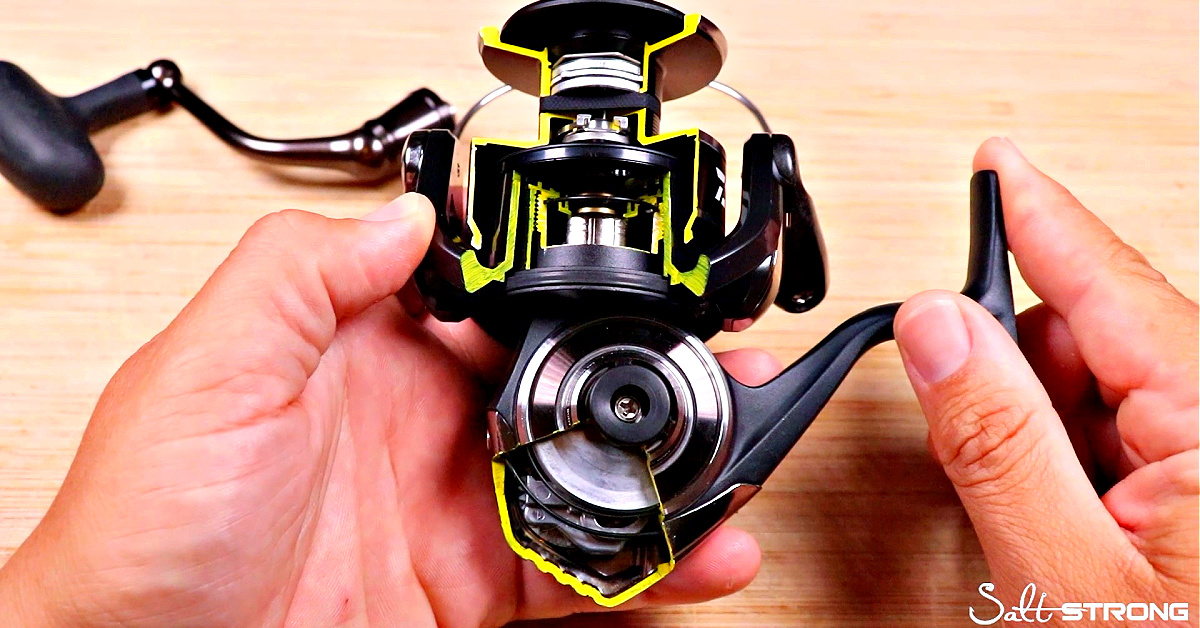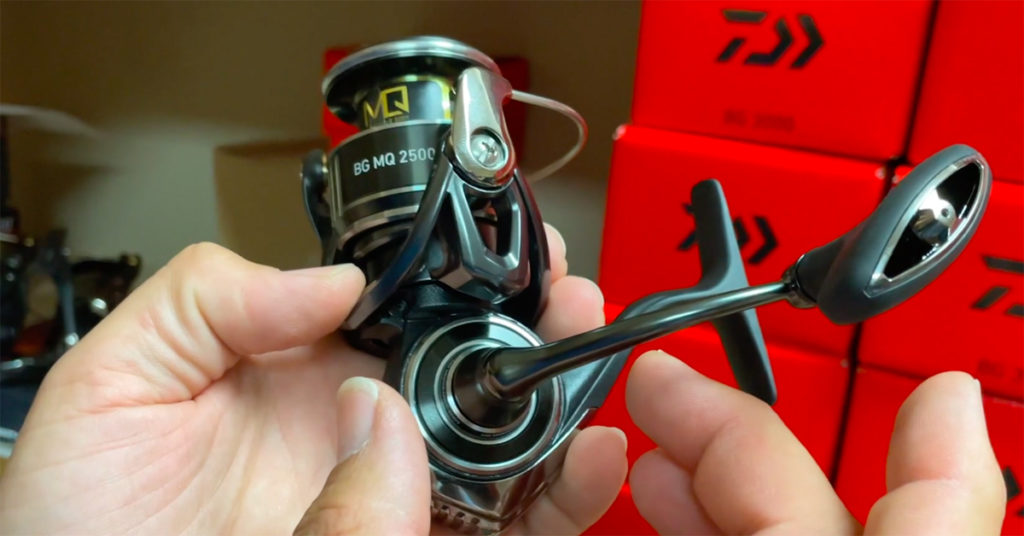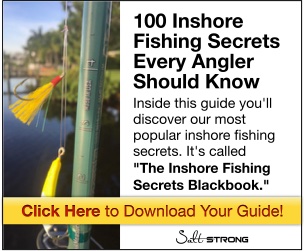You’ve Got To See The Inner Workings Of A Sealed Spinning Reel
- By: Justin Ritchey
- on

Have you ever seen the inner workings of a spinning reel?
How do manufacturers create a tight seal that protects the gears of the reel from water and other contaminants?
Spinning reels of today are extremely advanced and have unique operating systems!
Learn more down below!!
You’ve Got To See The #1 Way To Seal A Spinning Reel [VIDEO]

BG MQ Seal Locations
The Daiwa BG MQ Spinning Reel is a one-piece aluminum body reel.
MQ stands for “monocoque” which means “singular” or “one-piece”.
Traditional reels are two-piece that includes a side cap paired with screws that create compression along with a rubber gasket to form a seal around the gear of the reel.
MQ reels have a round, threaded plate on the side that has a rubber seal to provide 360 degrees of sealing.
The MQ body design provides a superior defense against water intrusion than most other reels.
The boot at the bottom of the reel helps prevent scratching or damage to your reel that may occur when fishing in various conditions.
A physical perimeter gasket runs the length of the boot to assist in water defense.
Beneath where the handle sits is a rubber press-fit seal that works in conjunction with the direct-drive handle system.
Opposite the handle, there is a cap that within it has a rubber gasket to further defend against water when threaded down tight.
At the top of the reel, there is a rubber seal just beneath the drag cap so contaminants do not affect the carbon fiber below.
Further down the main shaft, there is a press-fit seal above the rotor-retaining nut.
Underneath the rotor-retaining nut, there is another rubber-lipped seal leading into another rubber seal just above the anti-reverse clutch.
Lastly, there is a final seal overtop the anti-reverse clutch around the inner gears of the reel.
In total, the BG MQ has NINE seals to help prevent water contamination and damage to the workings and gears of the reel.
Magseal Technology
The BG MQ does not incorporate Daiwa’s Magseal technology into the function of the reel.
Magseal technology is a magnetic, oil-based liquid that works in conjunction with a magnetized plate on top of the anti-reverse clutch.
When the fluid works in tandem with the plate, it creates a chemical seal that is watertight and airtight.
This chemical interaction prevents water from entering the reel and traveling down to the inner workings of the reel.
Magseal is a wonderful feature to have but is not the end all be all of water prevention technology.
The ultimate seal for a spinning reel is Van Staal spinning reels.
The Van Staal reels are designed to be submerged underwater and require very minimal maintenance.
Van Staal only incorporates physical seals throughout the body of the reel.
The Daiwa BG MQ does not include Magseal protection but the physical sealing is advanced and provides a barrier to possible exposure areas to water and damage.
Daiwa has also removed the instant, anti-reverse feature on the front of the reel to fully eliminate a possible water access point.
The Daiwa BG MQ is a cleverly designed product to prevent water contamination using physical barriers in several locations.
Conclusion

The Daiwa BG MQ cutaway display reel reveals there are NINE seals to protect against and prevent water intrusion.
Despite not having the benefits of Magseal, the BG MQ is a well-protected reel equipped with many rubber seals in possible exposure spots.
Let me know your thoughts and experiences with either the BG MQ or other similar reels down in the comments!

And if you know someone who wants to know how their reel is sealed, please TAG or SHARE this with them!
P.S. Want access to our best fishing spots and tips, plus discounts to our online tackle store? Click here to join us in the Insider Club!
Related Articles:
Related categories:
STOP WASTING TIME ON THE WATER!
Do what the “SMART ANGLERS” are doing and join the Insider Club.
Here’s what you’ll receive today when you join:
- Weekly fishing reports and TRENDS revealing exactly where you should fish every trip
- Weekly “spot dissection” videos that walk you through all the best spots in your area
- Exclusive fishing tips from the PROS you can’t find anywhere else
- Everything you need to start catching fish more consistently (regardless if you fish out of a boat, kayak, or land).










What is the material of the rotor?
It’s made of a carbon composite material.
Excellent overview Justin.
More great info. Thank you.
Justin, this is great. I’m totally into overkill here, being a kayak fisherman who has had to disassemble reels to clean out the crunchy salt crystals that ground them to a halt. I’d love it if you guys would try a series of splash and immersion tests. I’ll certainly purchase a reel based on those results (assuming it costs less than the Van Staals at $600-800). Thanks, Phil
Thanks Philip, I’m right there with you. Better to have it & not need it, than need it & not have it.
If Daiwa can provide us with a Demo/Sample reel to perform these type of tests, we would definitely put them through the ringer.
Great review Justin! Thanks…again! I’m traditionally a Penn fan…built like tanks…but heavy like a tank too! Ha ha. But they take a licking and keep going (I rinse after every trip and do maintenance on them once a year).
That being said, I have 2 new Daiwa reels (BGMQ 2500 and Fuego 2500). I’m hoping they prove to be as reliable as my Penns are? Thanks for taking the time to explain the “how” on the BGMQ’s sealed properties. Only time and use will truly tell the story, but here’s hoping Daiwa got it right!
Yeah Buddy! Penn reels are also well sealed products. Some even have the IPX5 and IPX6 certification, so I have to tip my hat to the Spinfisher VI and Slammer III for their designs.
This video was terrific. I will definitely look into one when I’m in the reel market again.
Changing the subject Justin, I would like to know if a loop knot is still necessary with a lure when you are using a split ring?
Thanks Roy! Personally, I have not used a loop knot on any lure with a split ring. The split ring should serve as that “gap” that a loop knot would provide, therefore helping with lure performance.
Daiwa weaknesses used to be corrosion.
Conventional reels are built with drainage / air circulation slots so they can be flushed through.
Very few fixed spool reels can be serviced as spares are, by and large unobtainable.
As a contrast, all I had to do to recommission my Penn 114 6/0 Senator from the ’40s was to remove and save for authenticity, the asbestos based drag stack.
Van Staals do have the rep to match their formidable price tag.
I will never buy another Daiwa after the introduction of the original ‘Millionmax’
In the ’80s. Circa £1200.
Shimano have served me well for close range surf (150yds).
Am new to Penn fixed spools. Unsuitable back when for distance work.
‘Affinities’ will outcast almost anything.
‘Spinfishers’ have phenomenally progressive and powerfull drags.
I have X 3 live liners. 2500, 4500 & 6500. Finally picked up a couple of ‘Slammer IIIs’. 6500 and 9500.
Will pull up ‘Old Nick’. 40 & 50lbs. drag!
More than I can pull.
All so cheap in the UK and Oz, can treat them as single season expendibles.
Not much more than a load of hollow
braid and Quattro Fluoro top shot.
NB. Spools now carry all the important stuff. Spares are excitingly expensive so look after them, especially the front lip.
When the bodies get rough, get replacements off e-bay.
Handles already covered.
Some bespoke T grip handles are available for most heavy stuff.
That or padded gloves.
You really need ball races in the handles as well as the manual flyer line roller.
Everything else, who cares?
Malcolm Hayward.
Casting Coach
how much does the oil cost to replace?
I am not sure if Daiwa sells their Magseal Oil to the public. Most Authorized Daiwa Service Centers have small vials of the product and frequently service Magsealed Reels. But to purchase an aftermarket ferrous fluid by another brand, it costs around $40/ml (but it’s been a while since I checked).
looks like a lot of over kill to me
You can never be too overkill in keeping saltwater out of your reel. It’s been the cause of failure of most of the reels I’ve owned over the years. It’s the main reason a Van Staal will outlive almost any other reel.
I strongly agree, let’s face it , we double up on everything !!! Nothing worse then a seized reel.
Better to be safe than sorry! 🙂 The best part is that these seals have been implemented in a way where it does not negatively affect the fluidity of the reel (an unfortunate trade-off with a product like a Van Staal).
I bought one after opening a few of my reels and seeing rust everywhere, more overkill!
No matter what some moisture will eventually get in the reel. Do these same 9 seals keep the water from getting out or evaporating?
Correct, Gregory. Seals work both ways: they keep moisture out and, if there is a potential for water ingress, these same seals will keep water in. Fortunately, a healthy supply of quality grease also keeps water/moisture from entering the reel as well. If any moisture does leak by, it tends to emulsify with the grease (so the grease can be very helpful in this instance).
Currently the BG MQ has been on the market for about 1 year (the larger 6000+ sizes came out first and then the smaller 2500 Inshore sizes debuted back in March). Time will truly tell the long term effectiveness of these seals, but at first glance and after significant abuse with my personal BG MQ 6000, I have to say I’m impressed with the design.